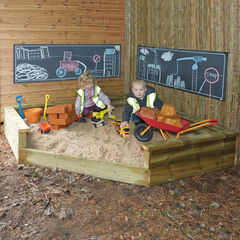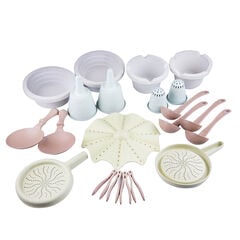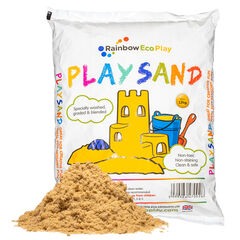In this blog, we will look at the value of sand and water play in the early years and look at how it can support the development of key skills in early childhood.
What is sand and water play in an early years setting?
Sand and water play is a vital aspect of any early years provision. Play opportunities in this area can evoke memories of holidays at the beach, visits to the park, or adventures by streams and rivers.
This type of play provides children with endless opportunities for imagination, exploration, investigation, and learning about the textures, movements, properties, and features of two of Earth’s most abundant raw materials.
When well-managed, sand and water play offers countless sensory benefits and supports the development of fine motor skills, social interactions, cooperation, and creativity.
Children naturally gravitate towards sand and water activities during free play, so providing various tools and toys is important to optimise play and learning in this area.
Why sand and water play is essential for early childhood development?
Sand and water play is engaging and fun. It introduces children to many areas of learning and supports the development of key skills. Here are some of the key skills that can be developed:
Sensory Development
The sensory values of sand and water play provide a calming and even therapeutic experience for children as their senses are aroused. This allows children to engage deeply in their learning. When the children are relaxed and have high engagement and involvement in their play, they both unconsciously and consciously take in information through their senses.
The sand’s texture and water’s fluidity offer children unique tactile experiences. They also learn about different properties and use a variety of language such as wet versus dry, and rough versus smooth, all while enhancing their sensory perception.
Developing Motor Skills
Manipulating sand and water and using different tools such as scoops, shovels, and containers, helps children develop their fine and gross motor skills. Children can often be found digging tunnels, patting down the sand to create a smooth surface, or using their fine motor movements as they write their names or make marks in the sand using their fingers.
Social Skills
Sand and water play often involves cooperation, sharing, and negotiation. However, children continuing to build confidence and skills in these areas can also play close to and alongside others until they feel ready.
Creativity and Imaginative Play
Sand and water play can provide many opportunities for imaginative play and artistic creations.
Sand’s malleability, open-ended nature, and sensory richness make it the perfect canvas for drawing and early writing. Children can draw and make marks in the sand using different accessories and tools, such as mashers and rolling pins, or natural resources, such as twigs and feathers. They can also take part in transient art as they arrange the materials they have found in artistic or systematic ways.
Water lends itself to many interesting and artistic experiments. Children can add paint, food colouring or natural materials such as petals to make all sorts of creative concoctions and investigate with colour changes.
Sand and water can also provide an ideal space for small world play as children work out the best consistency for building sandcastles, moats and different structures. Adding small world figures and vehicles or natural materials such as bark, stones and flowers can provide richness and detail to their small world creations. Children can add water to the sand to create rivers, lakes or castle moats.
Construction
Whilst playing with sand and water, some children might be more interested in the construction aspects rather than the creative opportunities. They can have a go at building bridges, sand castles, mountains, digging ravines, or digging out tunnels. They may wish to add waterways and watch the flowing water travel under the tunnels and bridges. This links to learning through STEAM as children can take on the roles of architect, engineer, and mathematician.
Learning through STEAM with sand and water
Sand and water play are ideal for developing STEAM concepts—Science, Technology, Engineering, Arts, and Maths.
When children engage with sand and water, they continuously experiment with different materials and consistencies, explore how water travels, and discover how they can use different tools to affect change. This type of scientific discovery is vital for developing problem-solving skills and understanding new concepts.
Children can develop mathematical concepts through a contextual, hands-on approach. This is developed when they experiment with changing the consistency of sand by adding water or participate in activities like measuring the materials, counting scoops, and comparing volumes. These play experiences help children grasp concepts such as measurement, quantity and size.
A supportive practitioner can ask open-ended and thought-provoking questions or provide a running commentary to spark critical thinking. Alternatively, if the child is immersed in their play, stand back and observe. Where are they in their play and what could we do as practitioners to enhance this learning further?
How to set up a sand and water play area in an early years setting
Creating a safe and engaging sand and water play area is important to maximise the learning benefits. Here are some tops tips to consider:
How to set up an indoor sand and water area
- For indoor setups, use large, shallow containers or specially designed sand and water trays or tables. Ensure that the area has wipeable surfaces or floors or is covered with a waterproof mat.
- Provide various tools and equipment for both the sand and water such as measuring cups, funnels, sieves, sponges, buckets, tweezers and moulds. Think about the opportunities for exploration, investigation and development. Do you have different sizes and shapes available? Does the equipment allow for challenge?
- Think carefully about how the tools and equipment are stored. Do you have shelves or baskets with simple labels or matching shapes on the shelves so that the children can access and tidy away the resources independently?
- Although practitioners may sometimes create invitations to play in this area, ideally, the sand and water trays should be empty of equipment at the start of most sessions so the children can decide and select the equipment they wish to use.
- Another helpful tip is to place a shelf across the sand and water tray. This allows children to rest containers on it while they are filling them or provides temporary storage for the toys and equipment during play.

How to set up an outdoor water and sand area or sandpit
- An outdoor play area often offers more flexibility and space than an indoor sand and water area. Designate a specific area, preferably with some shade to protect children from the sun.
- If possible, make the outdoor area bigger than indoors. This could be a sand tray or, even better, a sand pit where children can climb in and dig using their whole bodies.
- Try to provide an enclosure to protect play in the sandpit. When building a castle, road, or tower, you don’t want people charging through and knocking it over. Use either an enclosed sandpit or existing walls or fences as part of the surround, giving extra protection to their play and creations.
- Sand is a great resource but is elevated further when water is available. How can we make water available for play? If there isn’t a tap nearby or you want to make children aware of the importance of saving water, use a camping water barrel or let children transport water from elsewhere in the setting, e.g. a water tray. Not only does this make for great fun, but it also adds scientific exploration to their play.
- If possible, provide a place to sit near the sandpit and add some small brushes, such as nail brushes. Children can use these to clean the sand off their shoes and clothes. Having bigger dustpans and brushes nearby also encourages the children to sweep up any sand that has escaped during their play and is another opportunity to develop motor skills.
- Choose the right kind of sand, such as play sand (you can even try coloured play sand), that is safe for play. This is free from sharp bits, isn’t caustic, and won’t stain everything orange.
7 sand and water activity ideas
1. Scooping and pouring fun
Give children a chance to experience the concepts of measures and volume using pots and containers of varying sizes. As they scoop and transfer water or sand from one container to another, this adventure of pouring and filling will support the development of hand-eye coordination and motor skills. Watch their faces light up as they experiment and explore the concepts of capacity and spatial awareness.
2. Water experiments
Introduce children to the wonder of water by adding water cascades and spinners to your sand and water area. Pour water or sand on them and watch them spin. Another option is to add guttering and create dams. These activities encourage little scientists to experiment with different speeds and quantities, igniting their curiosity and understanding of cause and effect.
3. Sand sifting and sorting with sieves
Engage children in sand sifting and sorting. With the help of the sieves and shakers, they can separate the sand from other materials. From creating patterns to comparing textures, this activity enhances critical thinking skills and introduces children to basic scientific concepts. This can also lead to conversations about using sieves in other areas such as when we are baking and sieving flour etc.
4. Creative sand sculpting
Empower young artists to express their imagination through sand and water. Their own hands and other resources become tools of creation as they mould and sculpt sand into magnificent structures, whether towering sandcastles, magical creatures, or different landscapes. Can they experiment by adding water to the sand to see which combination makes the sturdiest structures? Does dry or wet sand work best? Why do they think this is?
This activity nurtures their fine motor skills, sparks imaginative play, encourages problem-solving, and brings their visions to life.
5. Mini Construction Site
To create a construction site, add mini diggers and trucks to scoop up and transport the sand from one place to another. Why not add a hand-operated digger to bigger outdoor sandpits for excavation activities or archaeological digs?
6. Finding treasure
Bury interesting resources in the sand to encourage children to dig, explore, and discover. They can retrieve and sort the objects using tools such as spades, metal detectors, trowels, tweezers, and tongs.

7. Sand pies
Mix sand and water to create ‘sand pies.’ Provide kitchen utensils, bun trays, cookie cutters, and moulds to encourage children to make a delicious feast for their friends.
What safety precautions are needed for sand and water play?
Safety is paramount. Consider the following:
- Is the sand and water safe, clean, and free of debris?
- Use non-toxic materials (safe play sand) and always check for sharp or broken tools.
- Make sure any outdoor sand pits or trays are covered, ideally with some netting or a ready-made cover. This ensures that animals and unwanted beasties can’t get in while allowing the sand to breathe and stay in good condition.
- Set boundaries and rules with the children, such as avoiding sand getting into their eyes and limiting the number of children in the area at once. Involve the children in this process by discussing the rules and making signs, posters or take images to place around the area as reminders.
- Ensure that the water is changed daily.
Reflective practice: Questions to consider when thinking about your sand and water area
- Are children able to access sand and water play both indoors and outside?
- Do you have enough resources to facilitate play in this area e.g. enough sand, access to water, different resources such as containers and tools of different shapes and sizes?
- Are the resources safe and in good condition? We need to keep children safe and ensure that the area is inviting and offers good play opportunities.
- Are the resources accessible and stored in a way that children can select and put them away independently?
- Are the resources cleaned regularly, e.g. to ensure stagnant water isn’t sitting in buckets or containers?
- Is learning in this space valued and championed by adults? Do interactions take place in the sand and water area? Children need to see the value of their play and achievements in all areas of the setting.
If you are interested in finding out more about water play, why not head over to a the blog by Dr Alistair Bryce-Clegg, where he talks about the ‘Common Play Behaviours and Skills Progression in the Water Play Area‘.
Shop our full range of sand and water resources here
Written by Michelle Reid. Michelle has over 20 years of experience working as a nursery nurse and qualified teacher in the Early Years and Primary sector.

































